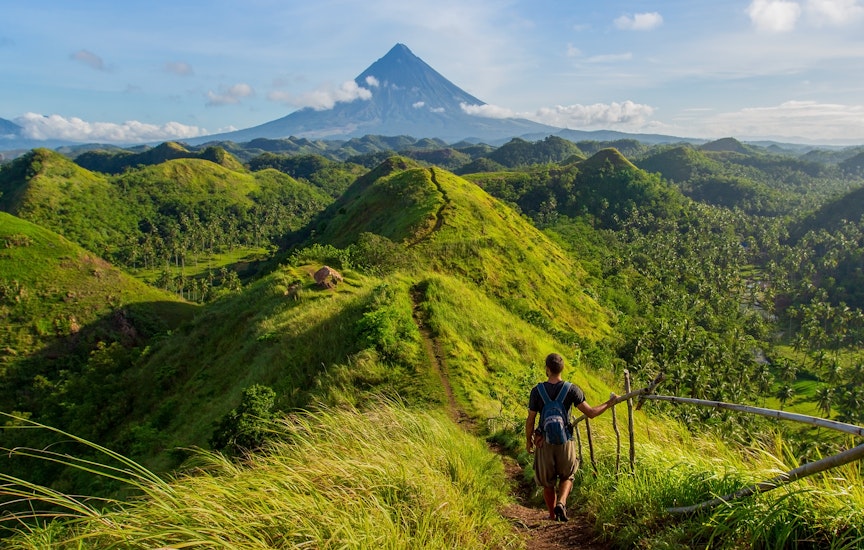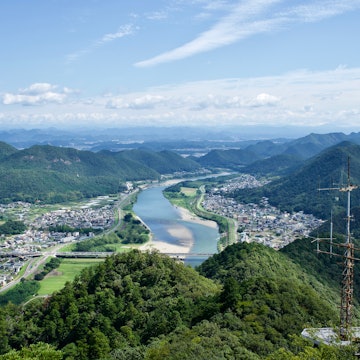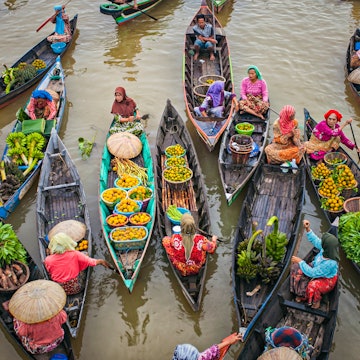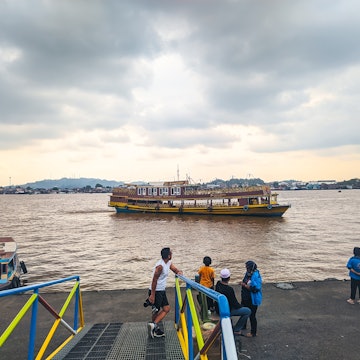

The crater of Pinatubo volcano, Philippines. posztos/Shutterstock
The mere mention of the Philippines evokes images of palm-fringed beaches and clear tropical lagoons.
For anyone eager to escape a gloomy climate, this sun-soaked archipelago in Southeast Asia promises a lush, tropical getaway. And in addition to the dreamy weather, the country offers a wealth of cultural experiences, vibrant local traditions and unmatched warm hospitality, too.
The Philippines has two major seasons: the dry season from December to May, and the rainy season from June to November. While you can enjoy the country’s many beaches year-round, the loads of sunshine and minimal rainfall of the drier months undoubtedly make for optimal for beach days. Yet traveling during the off-peak season means lower prices and the chance to enjoy beaches and islands – that is, if you manage to time your trip between typhoons.
Whatever you’re in the mood for, these are the best times to visit the Philippines.

November to May is the best time for beaches and island-hopping
Generally, the ideal months to hit the beach are December to May, when the weather is dry, sunny and perfect for outdoor activities like beach-bopping and island-hopping. November typically marks the arrival of good, dry weather in most of the country, including Manila, El Nido, Coron and Boracay.
Early November or mid-January to February are best bets to avoid the busy year-end holidays. Expect to shell out more and rub elbows during Holy Week (usually in March or April), local summer breaks and long weekends, when tourists descend en masse upon the most popular beaches.
But don’t worry: with more than 7000 islands in the country, there’s plenty of space for everyone. It's still possible to stumble upon secluded beaches even during the busiest time of the year, especially if you head to offbeat islands like Romblon, Masbate or the Eastern Visayas.
Lather on the sunscreen if you visit from March to May, when the rays get dialed up a notch. These warmest months of the year bring loads of sunshine, with occasional showers in May.

January to May is the best time to witness vibrant festivals
Festivals take place throughout the year in the Philippines – with the most frenzied (and photogenic) happening in the first quarter of the year. These include Ati-Atihan in Kalibo (the grandaddy of all Philippine fiestas), Sinulog Festival in Cebu and Dinagyang in Iloilo, which all take place on the third and fourth Sundays of January. Held in honor of the Santo Niño, or Infant Jesus, these festivals feature parades, dancing and raucous, weeklong street parties that draw crowds in the thousands.
During the popular Panagbenga Flower Festival in February, the northern mountain town of Baguio becomes a blooming spectacle with grand floral parades and spectacular floats adorned with roses, chrysanthemums, sunflowers and everlasting buds.
Lucban turns into a cornucopia of countryside charm come mid-May, when houses are adorned with fresh fruits, vegetables and kiping (colorful rice-paper wafers) during the Pahiyas Festival, a harvest event that honors the patron saint of farmers.

December to February is peak hiking season
December, January and February are the coolest, most pleasant months of the year to go hiking in the country’s gorgeous mountains. Most trails will be dry and safe to access, and the heat and humidity won’t be as high as in the summer months.
Beginner-level mountains are accessible on day trips from Manila – such as Mt Daraitan in Tanay in Rizal, which features spectacular summit views with caves and rivers nearby to explore. Mt Makiling in Los Baños, Laguna, is beautiful, with dense forests and mossy, dew-kissed trails. While Mt Pinatubo Crater Lake can be visited year-round, December to February is the ideal window, before the trail gets steamy enough to cook eggs on its volcanic terrain.
There’s a higher chance of witnessing the breathtaking sea of clouds in Mt Pulag (the “Playground of the Gods”) during these drier months. Hikers recommend February to March for clear skies and dreamy sunrise views (if you don’t mind single-digit temperatures at night). The summer months of March to May offer phenomenal views of the Milky Way, if you’re lucky enough to get a clear night.
December to April is the best time to explore underwater wonders
Months with milder weather also signal the best scuba diving and snorkeling season in the country. Calm seas and clear skies make visibility excellent, while the warmer water makes it easier to encounter marine life. December to March is the best time to go wreck-diving in Coron, Palawan. Even if you don’t dive, spot shipwrecks from above while snorkeling.
While it’s possible to dive year-round in some places like Mindoro (since the island is sheltered from typhoons by its neighboring islands), the rainy season can bring tropical showers, rough seas and cloudy skies. Even if the weather is perfect in Puerto Galera, ferries and boat trips to and from Batangas may be affected by the weather.
Some top diving spots like Tubbataha Reefs Natural Park are only accessible from mid-March to mid-June, with liveaboards typically lasting from six nights and seven days to 11 nights and 12 days. Plan accordingly.

February to May is the best time to spot whale sharks
If on your bucket list is a swim with whale sharks, visit in the first few months of the year. From November to June, these gentle giants roam the waters of Donsol, in the province of Sorsogon, while February to May offer the highest chance for divers and snorkelers to spot them in the wild. Operators in Donsol don’t engage in shark feeding, which unfortunately remains a common practice in other parts of the country.

June to October is best for budget travelers and chasing waterfalls
To save on costs and avoid crowds, the off-peak months from June to October might appeal. The wetter months of the year typically bring rain and typhoons, which can make travel unpredictable. Yet budget travelers can take advantage of low-season rates to enjoy beaches and tourist spots without feeling rushed.
Accommodations, tours and flight prices drop during the low season, since the weather can still be unpredictable. For minimal disruptions, stay in areas less prone to storms (such as Palawan, Boracay, Cebu and Mindoro) and avoid regions facing the Pacific Ocean.
The wet season is also a good time to chase waterfalls and enjoy adventures beyond the beach like canyoneering and cliff jumping in Cebu’s Kawasan Falls. The cascades of Kaparkan Falls, a stunning waterfall in Abra whose terraces create natural spring-water pools, are at their fullest and most beautiful during the rainy months from July to October.
White-water rafting in Cagayan de Oro is amazing in the rainy months, when the river is higher, making rapids more exciting. Take a detour to the island of Camiguin, which has its share of waterfalls and lovely hot springs, cold springs and soda springs to soak in.
July to November is a swell time for advanced surfers
There are two distinct surfing seasons based on the Philippines’ monsoon seasons. Known as amihan (or northeast monsoon season), December to March typically sees smaller waves on the west coast and is better for beginner surfers in areas like San Juan in La Union.
Intermediate and pro surfers who want to catch epic waves on the eastern seaboard will want to time their trips from July to November. The habagat (southwest monsoon season – which also marks typhoon season) often brings bigger waves to top surfing spots like the Majestics in Catanduanes, Baler’s Point break, Siargao’s legendary Cloud Nine or far-flung Calicoan Island’s ABDC reef breaks.

September marks the start of the festive Christmas season
Christmas carols start playing in malls as early as September, as the country revs up the world’s longest Christmas season. The “-ber months” — September through December — bring a seemingly nonstop procession of events, year-end fairs, light displays and all-out celebrations across the country.
September and October are great months to visit mountain towns like Baguio and Sagada. Holiday decorations turn the towns into Christmas villages, and you can enjoy the crisp and cool weather amid the pine-tree forests – without the full force of the tourist crowds just yet.
Come December, the high season ramps up and takes off at full speed. The last few days of the year, from Christmas to New Year, are a frenetic peak period that requires careful planning. You’ll need to summon plenty of patience when dealing with city traffic, airport lines and sourcing a cab. Expect to be elbow-to-elbow with other customers when you dine out: it’s a lot...but you’ll be in the thick of all the action. If you prefer solitary getaways to socializing, consider escaping to offbeat islands or lesser-visited countryside retreats.
















